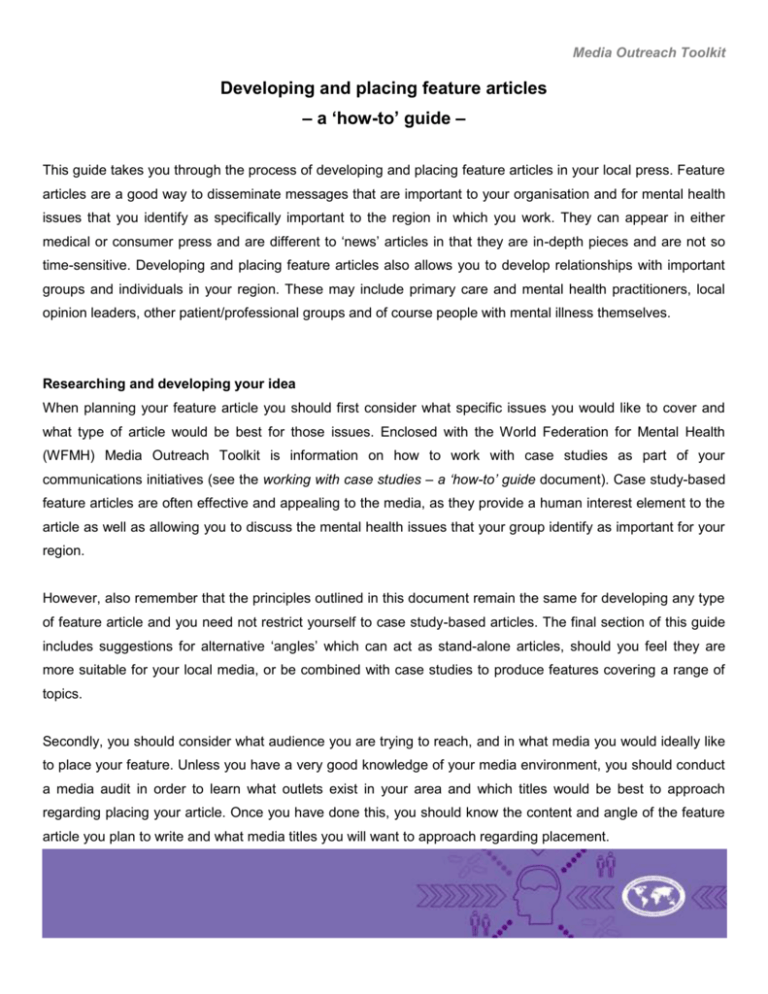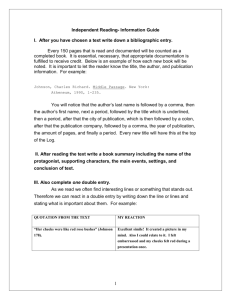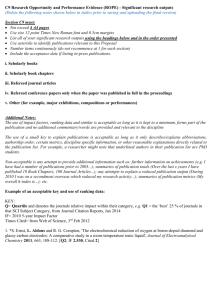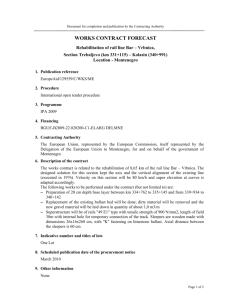Developing and placing feature articles
advertisement

Media Outreach Toolkit Developing and placing feature articles – a ‘how-to’ guide – This guide takes you through the process of developing and placing feature articles in your local press. Feature articles are a good way to disseminate messages that are important to your organisation and for mental health issues that you identify as specifically important to the region in which you work. They can appear in either medical or consumer press and are different to ‘news’ articles in that they are in-depth pieces and are not so time-sensitive. Developing and placing feature articles also allows you to develop relationships with important groups and individuals in your region. These may include primary care and mental health practitioners, local opinion leaders, other patient/professional groups and of course people with mental illness themselves. Researching and developing your idea When planning your feature article you should first consider what specific issues you would like to cover and what type of article would be best for those issues. Enclosed with the World Federation for Mental Health (WFMH) Media Outreach Toolkit is information on how to work with case studies as part of your communications initiatives (see the working with case studies – a ‘how-to’ guide document). Case study-based feature articles are often effective and appealing to the media, as they provide a human interest element to the article as well as allowing you to discuss the mental health issues that your group identify as important for your region. However, also remember that the principles outlined in this document remain the same for developing any type of feature article and you need not restrict yourself to case study-based articles. The final section of this guide includes suggestions for alternative ‘angles’ which can act as stand-alone articles, should you feel they are more suitable for your local media, or be combined with case studies to produce features covering a range of topics. Secondly, you should consider what audience you are trying to reach, and in what media you would ideally like to place your feature. Unless you have a very good knowledge of your media environment, you should conduct a media audit in order to learn what outlets exist in your area and which titles would be best to approach regarding placing your article. Once you have done this, you should know the content and angle of the feature article you plan to write and what media titles you will want to approach regarding placement. Media Outreach Toolkit Choosing an author There are three options for whom your feature could be authored by: A local opinion leader (an expert in some area of mental health who lives and works in your region) A representative of your group (the director or CEO for example) A journalist at your targeted publication If you have a strong existing relationship with a local opinion leader, the preferred option may be to use him or her to write your article. The opinion from a respected professional is often the most impressive and attractive to media outlets and their readers. If your organisation is well-known and respected in your region, an equally strong option may be to have a senior figure from your group author the article. The opinion of an established patient group is also often seen as informed and important, as patient groups are typically considered to reflect the real needs of the people with mental illness that they represent. When you contact a targeted media outlet to place the article, you could approach a specific journalist and ask them if they would be interested in authoring the feature themselves. Many journalists are very well respected and their opinion highly valued, so you should do your research first to identify someone who has relevant experience and who will do justice to the topics you intend to discuss in the feature. Remember, once you have confirmed your preferred author you should work with them throughout the writing process to ensure they are covering the topics you want to discuss in a way that is appropriate for the aims and objectives of your organisation. You may be able to ‘ghost write’ the article on their behalf (either yourself or by employing a freelance writer) and then give it to your author for their comments and approval. However, if the article is being written by an opinion leader or a journalist, there will be a level of compromise regarding how much control you will have over the article’s development. Finally, you may want to place two, three or even more articles in different media outlets over the course of a year. If you do want to do this, you should consider using different authoring strategies throughout the course of your overall feature programme. Media Outreach Toolkit Approaching targeted media outlets Establish the interest of your target publication by making a phone call on behalf of the author to discuss the feature idea. You should write a one-page overview of the feature article outlining the rationale and proposed content, which you can share with the publication to help give structure to your conversations (this may also be useful to share with opinion leaders when approaching them as potential authors). When discussing the feature idea with the publication, be prepared to consider incorporating additional/different topics if suggested. You should establish the outlet’s basic requirements including the word limit, what visual images they would like (photographs of your case study for example), whether they will want to use summary boxes within the article to create visual interest on the page and any other requirements that the publication may have. Finally, you should agree a timeframe for completion and publication of your feature. The whole process can take several months, sometimes even longer, and some publications plan the content of their issues up to three months in advance of publication. Allow enough time for drafting and approving the article both internally at your organisation, with your opinion leader author if appropriate and also with the editorial team at the publication. Remember that final editorial control is held by the publication and they may decide to modify your copy depending on their needs. They will not necessarily be obliged to share these changes with you prior to publication. By this stage you should have agreed the outline of your feature with the author and the media outlet that will publish the article. You should also have agreed timeframes for completion, approval and publication and be ready to start the writing process proper. Writing your feature How your feature article is written will depend to some extent on who your author is. If you, or a ghost writer you employ, are writing the article on behalf of an opinion leader, you should discuss the content with them in detail before you start writing to ensure that you are developing a piece that is in-line with their expectations. Once your draft is ready, send it to the author in the format they prefer and provide them with a deadline for returning comments. You may have to go through this process several times before you have a final approved version ready to submit for publication. Media Outreach Toolkit If your article is being written by a journalist from the publishing outlet you should again discuss the content in detail before they start, this time to ensure that they are developing a piece in-line with your expectations. If the article is being developed in-house at your organisation, you should have greater control throughout the writing process to ensure that the article is developing in a way appropriate to your aims and objectives. Throughout the writing process you should take responsibility for sourcing appropriate photography and other imagery that will appear in the final printed article (there may be royalty payments associated with this). If your article is case study-based, you should also facilitate any liaison between the author and the case study. Enclosed in the WFMH Media Outreach Toolkit is information on working with case studies. For the purpose of feature articles, you should ask your case study whether they are happy to be contacted directly by the author or whether all liaisons should go through you. Supporting materials In addition to submitting the final article for publication, it may also be appropriate to supply the media outlet with background information on relevant topics. This toolkit includes a template mental health and metabolic syndrome media backgrounder, a backgrounder on the WFMH and a global facts and statistics document on mental health and metabolic syndrome. These supporting documents can be sent to media outlets as they are or adapted (and translated if necessary) to apply locally in your region. For example, you may already have or wish to develop a backgrounder on your specific organisation, and you may want to develop a document with facts and statistics on mental health specific to your region. These extra materials may be used by a journalist author when writing your feature, but also help to raise the profile of your organisation and the issues that are of concern to you and the people you represent. Media Outreach Toolkit The feature article process Research and plan feature article Draft outline Sell-in to media Write first draft & supporting materials Redraft and approve Submit article to publication Ongoing media relationships Once you have your feature article placed, ensure you keep a database of all media you researched during your initial planning stage and all media you contacted as targets for publication. This database will form the basis for all future media activity and should include: Information on the types of stories covered by specific media, including examples should you so wish Up-to-date contact details for relevant media and individual journalists Feedback from your discussions when placing the article Details of your experiences and feedback from approaching opinion leaders as potential authors Media Outreach Toolkit You should monitor key media regularly (ideally on a day-to-day basis) to keep yourself informed of topics relevant to mental health that the media in your region are discussing. This will also allow you to identify potential opportunities for placing additional feature articles as you progress with your communications initiatives. Other feature ideas The primary purpose of the WFMH Media Outreach Toolkit is to facilitate the development of case study-based feature articles. However, there may very well be opportunities in your local media for features based on other material that you should also consider. These may include: Developments in treatment guidelines and/or protocols Historical discussion on changes in incidence and/or prevalence of mental illness in your region Profiles of opinion leaders (clinicians, inspirational awareness campaigners etc) Government policy on mental illness There may also be other topics that you feel you would like to discuss and you should consider including these alongside case studies and other feature ideas to create an interesting and diverse feature programme as part of your group’s communications initiatives. Remember also that the closer you monitor the media and engage in feature proposal discussions with journalists, the better you will understand your media environment and the better equipped you will be to develop and place feature articles in the future.








